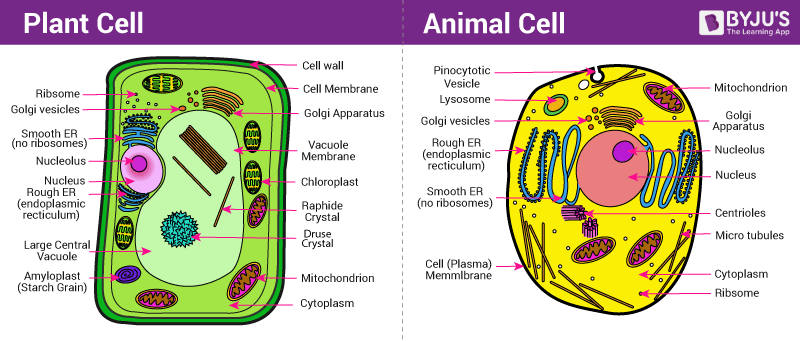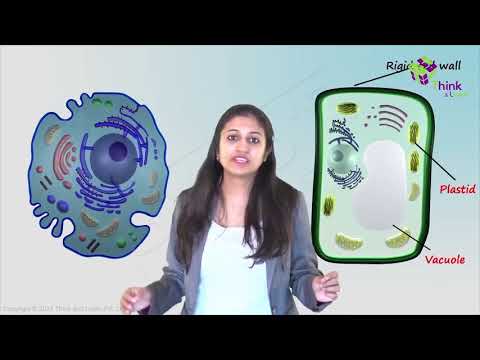A Easy to See Diagram of a Plant Cell
The cell is the fundamental unit of life. All the life activities are carried out by cells. The organisms are classified based on the number of cells present in them. Unicellular organisms are single-celled, while multicellular organisms have a large number of cells.
Unicellular organisms are believed to be one of the earliest forms of life on earth. Eventually, more complex multicellular organisms evolved from these unicellular life forms over the aeons. Multicellular organisms have specialized cells with complicated cell organelles, which unicellular organisms typically lack.
In an ecosystem, plants have the role of producers while animals have taken the role of consumers. Hence, their daily activities and functions vary, so do their cell structure. Cell structure and organelles vary in plants and animals, and they are primarily classified based on their function. The difference in their cell composition is the reason behind the difference between plants and animals, their structure and functions.
Each cell organelle has a particular function to perform. Some of the cell organelles are present in both plant cell and the animal cell, while others are unique to just one. Most of the earth's higher organisms are eukaryotes, including all plant and animals. Hence, these cells share some similarities typically associated with eukaryotes.
For example, all eukaryotic cells consist of a nucleus, plasma membrane, cytoplasm, peroxisomes, mitochondria, ribosomes and other cell organelles.
Also Read: Cells
Differences Between Plant Cell and Animal Cell

Diagram showing the Difference between Plant cell and Animal cell
As stated above, both plant and animal cells share a few common cell organelles, as both are eukaryotes. The function of all these organelles is said to be very much similar. However, the major differences between the plant and animal cells, which significantly reflect the difference in the functions of each cell.
The major differences between the plant cell and animal cell are mentioned below:
| Plant Cell | Animal Cell |
| Cell Shape | |
| Square or rectangular in shape | Irregular or round in shape |
| Cell Wall | |
| Present | Absent |
| Plasma/Cell Membrane | |
| Present | Present |
| Endoplasmic Reticulum | |
| Present | Present |
| Nucleus | |
| Present and lies on one side of the cell | Present and lies in the centre of the cell |
| Lysosomes | |
| Present but are very rare | Present |
| Centrosomes | |
| Absent | Present |
| Golgi Apparatus | |
| Present | Present |
| Cytoplasm | |
| Present | Present |
| Ribosomes | |
| Present | Present |
| Plastids | |
| Present | Absent |
| Vacuoles | |
| Few large or a single, centrally positioned vacuole | Usually small and numerous |
| Cilia | |
| Absent | Present in most of the animal cells |
| Mitochondria | |
| Present but fewer in number | Present and are numerous |
| Mode of Nutrition | |
| Primarily autotrophic | Heterotrophic |
Conclusion
Both plant and animal cells comprise membrane-bound organelles, such as endoplasmic reticulum, mitochondria, the nucleus, Golgi apparatus, peroxisomes, lysosomes. They also have similar membranes, such as cytoskeletal elements and cytosol. The plant cell can also be larger than the animal cell. The normal range of the animal cell varies from about 10 – 30 micrometres and that of plant cell range between 10 – 100 micrometres.
Also Read:Cellulose in Digestion
Difference between the plant cell and animal cell is an important topic for Class 8 students and higher. Discover other important topics by visiting BYJU'S.

Frequently Asked Questions
Which cell organelles are present only in plant cell and absent in animals cell?
Plant cells have a cell wall and plastids that animal cells lack.
How do plant cells and animal cells differ with respect to their shape?
A plant cell has a square or rectangular shape while the animal cells have an irregular or round shape.
Why are plant cells generally larger in size compared to the animal cells?
Plant cells comprise a large central vacuole that occupies a majority of the volume and makes the cell larger. This vacuole is usually absent in the animal cell.
What is the function of vacuoles in a plant cell?
The vacuole stores waste material in a plant cell. It also maintains proper pressure in a plant cell that helps in providing proper support and structure to the growing plants.
Name some cell organelles present exclusively in animal cells.
Animal cells comprise lysosomes and centrosomes that are completely absent in a plant cell.
Name the cell organelle responsible for providing structural support for plant cells apart from the cell wall.
The central vacuole provides structural support to the plant cell.
Name the cell organelle responsible for carrying out photosynthesis in plant cells.
Chloroplasts are responsible for carrying out photosynthesis in a plant cell.
Source: https://byjus.com/biology/difference-between-plant-cell-and-animal-cell/

0 Response to "A Easy to See Diagram of a Plant Cell"
Post a Comment